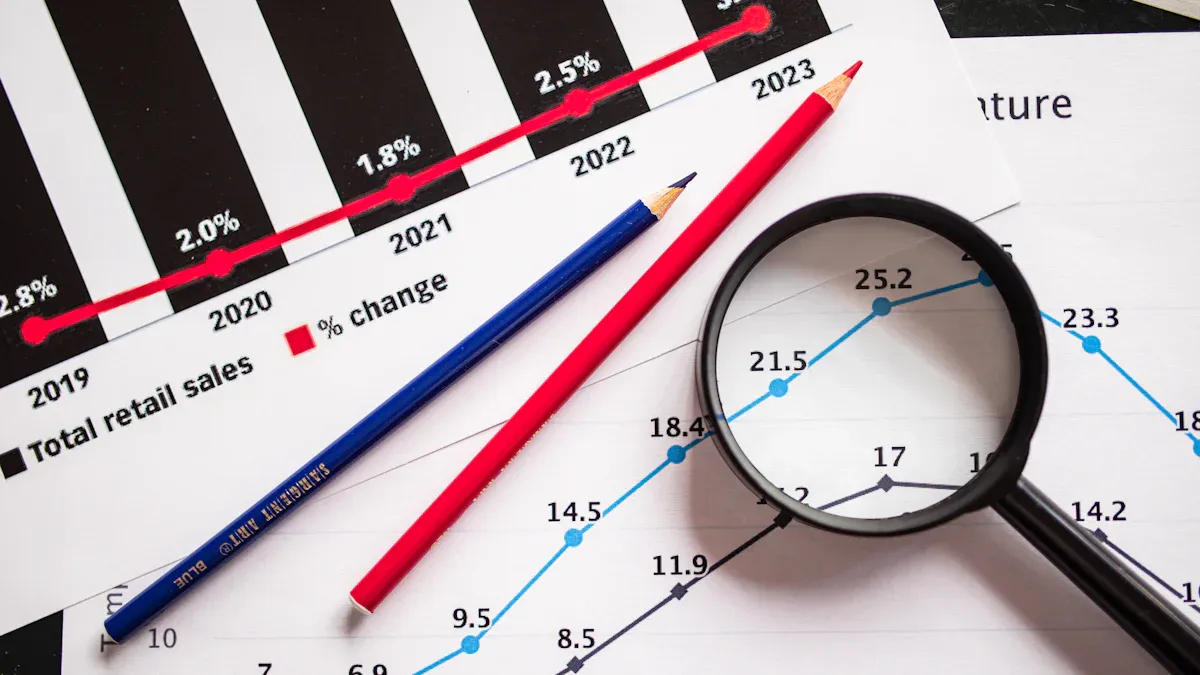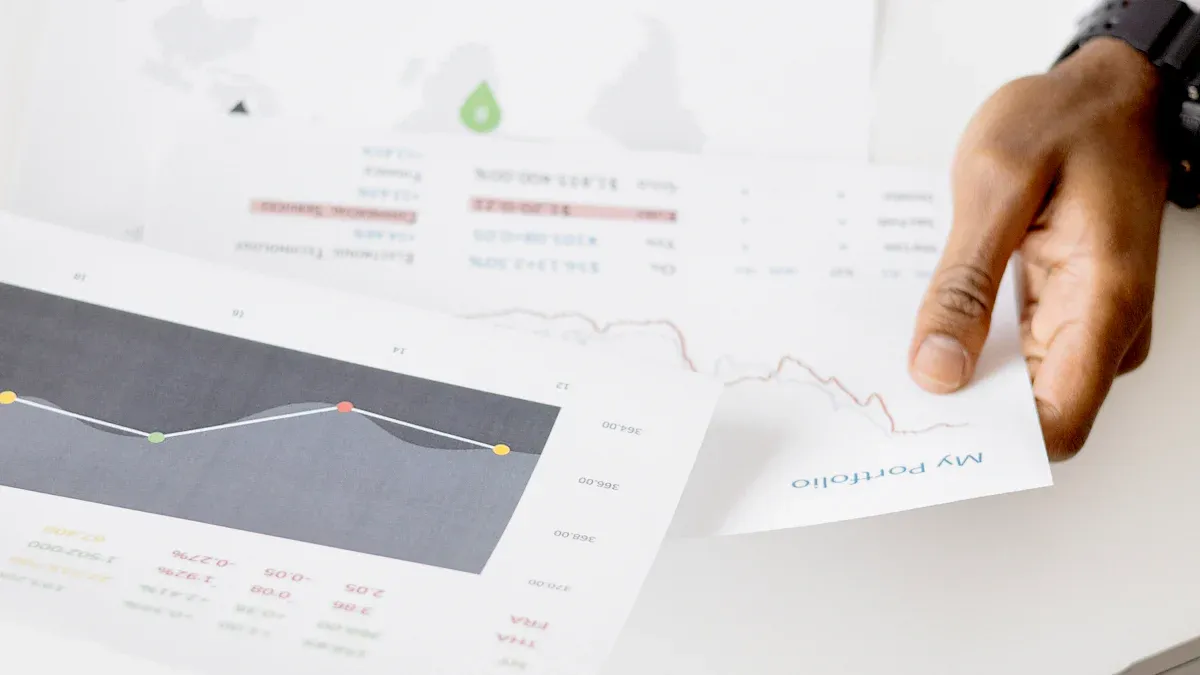Short-Term Demand Forecasting: Methods & Pitfalls

Accurately predicting customer demand is crucial for managing inventory and making sound operational decisions. Short-term demand forecasting helps you avoid costly mistakes that can disrupt your business. For example:
Stockouts result in lost revenue and harm customer relationships.
Overstocking ties up your capital and increases storage costs by as much as 30%.
Poor inventory management can cause businesses to lose up to 11% of annual revenue.
By leveraging forecasting tools, you can reduce inefficiencies, lower holding costs, and improve customer satisfaction. However, challenges like data quality, market shifts, and seasonality can complicate the process, making it essential to adopt both effective methods and a proactive mindset.
Key Takeaways
Predicting demand correctly avoids problems like running out of stock or having too much, which can hurt money and customer trust.
Use expert advice along with math tools like averages to make better predictions.
Pay attention to market changes and outside events to improve forecasts; ignoring them can mean losing chances.
Use good data systems to make sure your predictions are based on trustworthy information and have fewer mistakes.
Check and update your prediction methods often to keep up with market changes and get better results.
Methods for Short-Term Demand Forecasting

Short-term demand forecasting relies on a mix of methods to predict customer needs accurately. Each approach has its strengths and is suited for specific scenarios. Below, you’ll find an overview of the most common methods.
Qualitative Approaches
Qualitative methods focus on expert opinions and market insights rather than numerical data. These approaches are especially useful when historical data is limited or when launching new products.
Expert Opinion: Consulting industry experts can provide valuable insights into market trends and customer behavior. For example, combining expert advice with statistical models has helped technology companies improve renewal rates and stabilize revenue streams.
Market Research: Surveys, focus groups, and customer feedback help you understand demand patterns. In the food and beverage industry, market research combined with regression analysis has improved marketing ROI and supported successful product launches.
Tip: Use qualitative methods when entering new markets or dealing with unpredictable demand. Pair them with quantitative techniques for better accuracy.
Quantitative Techniques
Quantitative methods rely on mathematical models and statistical tools to analyze historical data. These techniques are ideal for businesses with consistent demand patterns.
Some of the most effective quantitative methods include:
Moving Average: This method smooths out fluctuations by averaging past data points. Retailers often use it to reduce holding costs and improve service levels during peak seasons.
Exponential Smoothing: Similar to moving averages, this method gives more weight to recent data, making it responsive to sudden changes.
STL Decomposition: This technique separates data into seasonal, trend, and residual components. Manufacturers have used it to reduce overtime costs and shorten production lead times.
Here’s a quick comparison of forecasting methods and their effectiveness:
Forecasting Method | Effectiveness | Notes |
|---|---|---|
Traditional Methods | Lower precision | Suitable for simple, stable demand scenarios |
Machine Learning | Higher precision | Handles complex relationships and nonlinear patterns |
Note: Combining multiple quantitative methods often yields better results. For instance, blending moving averages with exponential smoothing has proven effective in the retail sector.
Advanced Methods Using Machine Learning
Machine learning (ML) has revolutionized short-term demand forecasting by offering unparalleled accuracy. These models excel at identifying patterns in large datasets and adapting to changing conditions.
Some popular ML models include:
Random Forest Regression: This model handles nonlinear relationships well and works effectively for minute-level forecasts. However, it may face overfitting challenges in certain cases.
Logistic Regression: Known for its high accuracy in one-day forecasts, this model has been particularly effective in financial simulations.
ARIMA with Expert Opinion: Combining ARIMA with qualitative insights has helped businesses in the technology sector increase renewal rates.
The table below highlights the accuracy rates of different machine learning models:
Model Type | Accuracy Rate | Time Frame | Notes |
|---|---|---|---|
Random Forest Regression | High | Minute-level | Enhanced with technical indicators, but faced overfitting challenges. |
Logistic Regression | Highest | 1-day | Highest accuracy for 1-day data, but financial simulations showed different revenue results. |
Random Forest | Higher | 15-min | Higher accuracy than 1-day, but lower revenue generated compared to 1-day strategy. |
Tip: Machine learning models are most effective when paired with high-quality data and domain expertise. Start small and scale up as you gain confidence in the results.
By understanding these methods, you can choose the right approach for your business needs. Whether you rely on expert opinions, statistical models, or advanced machine learning, the key is to adapt your strategy to the complexity of your demand patterns.
Pitfalls in Short-Term Demand Forecasting

Short-term demand forecasting can significantly improve your business operations, but it comes with challenges. Understanding these pitfalls can help you avoid costly mistakes and refine your forecasting strategy.
Overreliance on Historical Data
Relying too heavily on historical data can lead to inaccurate forecasts, especially in fast-changing markets. While past sales trends provide valuable insights, they don’t always account for evolving customer preferences, technological advancements, or sudden market disruptions.
Forecasting inaccuracies caused by overreliance on historical data range from 20% to 50%.
These errors contribute to a staggering $1.1 trillion in global supply chain waste annually.
In 2022, nearly two-thirds of small and mid-sized businesses reported losing 15% or more in revenue due to supply chain delays.
Historical data alone cannot capture the full picture. For example, a retailer using only past sales data might fail to anticipate a surge in demand driven by a viral social media trend. To mitigate this risk, you should integrate real-time data and external factors into your forecasting models.
Tip: Combine historical data with current market insights to create a more balanced and accurate forecast.
Ignoring Market Trends and External Factors
Focusing solely on internal data while ignoring external influences can limit your understanding of the market. Economic conditions, competitor actions, and shifting consumer behaviors all play a critical role in shaping demand.
Neglecting external factors often results in a narrow view of the market, leading to missed opportunities or overstocking.
A comprehensive approach that combines historical data with current trends and future-oriented indicators is essential for accuracy.
For instance, a company that overlooks rising inflation rates might underestimate the impact on consumer spending habits. Similarly, ignoring competitor promotions during the holiday season could lead to overestimating your own sales. By staying informed about market trends and external factors, you can adjust your forecasts to reflect real-world conditions.
Callout: Keep an eye on industry reports, economic forecasts, and competitor activities to enhance your forecasting accuracy.
Data Quality and Availability Issues
Poor data quality can undermine even the most sophisticated forecasting models. Missing, outdated, or incorrect data skews your predictions and leads to unreliable results.
A retail company forecasting demand for a product may encounter issues if historical sales data contains missing values or errors.
Missing records during promotional periods can distort seasonality patterns, making it harder to predict future demand accurately.
To address this, you should prioritize data accuracy and completeness. Regularly audit your datasets, fill in gaps, and correct errors to ensure your forecasts are based on reliable information. High-quality data forms the foundation of effective short-term demand forecasting.
Note: Invest in robust data management systems to minimize errors and improve the reliability of your forecasts.
Seasonality and Demand Variability Errors
Seasonality and demand variability often create significant challenges in short-term demand forecasting. Seasonal patterns, such as holiday shopping spikes or back-to-school sales, can cause sudden shifts in demand. If you fail to account for these fluctuations, your forecasts may lead to overstocking or stockouts, both of which harm your bottom line.
Demand variability adds another layer of complexity. Products with shorter lifecycles or those influenced by trends often experience unpredictable demand. For example, a fashion retailer might struggle to forecast demand for a new clothing line influenced by social media trends. Traditional forecasting methods relying solely on historical data often fall short in these scenarios.
Research highlights the limitations of conventional methods in addressing seasonality and variability. One study emphasizes that shorter product lifecycles and volatile demand make historical sales data insufficient for accurate predictions. It suggests combining forecasting techniques with judgmental adjustments to improve accuracy. Another study introduces a Fourier time-varying grey model (FTGM) that adapts to seasonal variations using advanced algorithms. This model outperforms traditional methods by accounting for time-varying trends and limited data, making it a valuable tool for managing seasonal demand.
To address these challenges, you should adopt a proactive approach. Start by identifying seasonal patterns in your data. Tools like STL decomposition can help separate seasonal components from overall trends. For products with high variability, consider using machine learning models that adapt to changing conditions. Combining these methods with expert insights ensures your forecasts remain accurate, even in unpredictable markets.
Tip: Regularly review your forecasting models to ensure they align with current demand patterns. Adjust for seasonality and variability to avoid costly errors.
Solutions to Overcome Forecasting Challenges
Improving Data Accuracy and Completeness
Accurate and complete data forms the backbone of effective short-term demand forecasting. Missing values, outliers, and biases can distort predictions, leading to costly errors. You can mitigate these challenges by implementing robust data collection, validation, and cleaning processes.
Organizations that prioritize data-driven decision-making improve forecasting accuracy and operational efficiency.
Reliable data minimizes errors caused by subjective judgment, ensuring precise predictions.
Historical data combined with analytics enhances business performance by grounding decisions in reality.
Regular audits of your datasets help identify inconsistencies and gaps. By addressing these issues, you create a solid foundation for your forecasting models.
Tip: Invest in tools that automate data cleaning and validation to save time and reduce errors.
Incorporating Real-Time and External Data
Real-time and external data sources significantly enhance forecasting accuracy. Economic indicators, weather patterns, and social media trends provide valuable insights that complement internal data. For example, weather data can predict demand for seasonal products, while social media sentiment highlights emerging trends.
APIs for real-time data integration allow dynamic updates to forecasting models.
Hybrid models combining deep learning and statistical methods adapt to changing conditions.
Feedback loops analyze outcomes and recalibrate forecasts for continuous improvement.
Inconsistent data structures across sources can complicate integration. Address this by standardizing formats and ensuring data quality. Leveraging external data streams helps you stay ahead of market shifts and customer preferences.
Callout: Use adaptive learning techniques to refine your models based on real-time insights.
Using Scenario Planning and Sensitivity Analysis
Scenario planning and sensitivity analysis prepare you for uncertainties in demand forecasting. These techniques simulate various outcomes based on changing conditions, helping you identify risks and opportunities.
Description | Outcome | |
|---|---|---|
Oil Spill Response Planning | Simulated oil spill scenarios to develop response plans. | Improved safety protocols post-incident. |
Financial Stress Testing | Banks simulated economic downturn scenarios. | Enhanced risk management strategies. |
Pharmaceutical Pricing Strategies | Analyzed pricing scenarios for new drugs. | Insights into revenue and patient access. |
By exploring multiple scenarios, you gain a deeper understanding of how external factors impact demand. Sensitivity analysis highlights the variables most likely to influence outcomes, enabling you to adjust your strategies accordingly.
Note: Regularly update your scenarios to reflect current market conditions for better reliability.
Enhancing Collaboration Across Teams
Effective collaboration across teams plays a vital role in improving the accuracy of short-term demand forecasting. When teams work together seamlessly, they share insights, reduce biases, and create forecasts that reflect a broader perspective.
To foster collaboration, focus on these key practices:
Clear Communication: Ensure team members exchange information openly and consistently. Miscommunication often leads to forecasting errors.
Defined Roles: Assign specific responsibilities to each team member. For example, designate who collects data, who analyzes trends, and who facilitates discussions.
Feedback Loops: Regularly review forecasting outcomes and adjust processes based on feedback. This continuous improvement cycle enhances accuracy over time.
A structured approach to collaboration improves forecasting outcomes. The table below highlights practices that support better teamwork and results:
Collaboration Practice | Description |
|---|---|
Bias | Assess whether forecasts consistently overestimate or underestimate actual outcomes. |
Consensus Level | Evaluate how well the team converges toward a consensus forecast. High consensus indicates effective collaboration. |
Lead Time Accuracy | Consider how well forecasts predict events at different lead times (short-term vs. long-term). |
Communication Quality | Effective collaboration relies on clear communication. Evaluate how well team members share information. |
Trust and Psychological Safety | Trust fosters open discussions and better forecasts. Psychological safety encourages dissenting opinions. |
Adaptability | Assess how well the team adapts to changing conditions. Flexibility is crucial in dynamic environments. |
Collaboration Process | Analyze the steps involved in collaborative forecasting. Is there a structured process for data collection? |
Roles and Responsibilities | Clarify roles within the team. Who collects data, who runs models, and who facilitates discussions? |
Feedback Loops | Regularly review and adjust the forecasting process based on feedback for continuous improvement. |
Tip: Build trust within your team to encourage open discussions. Psychological safety allows members to share dissenting opinions, which often lead to better forecasts.
By enhancing collaboration, you create a forecasting process that adapts to changing conditions and minimizes errors. Strong teamwork ensures your short-term demand forecasting remains accurate and reliable.
Flexibility and Integration in Forecasting
Adapting to Market Changes
Markets change rapidly, and your forecasting methods must keep up. Adapting to these shifts ensures your business remains competitive and responsive. For example, a global retailer combined machine learning with traditional regression models to reduce excess inventory and improve customer service. Similarly, automotive manufacturers used simulation models to adjust to changing consumer preferences, stabilizing production cycles and increasing market share.
To stay ahead, you should monitor real-time data and adjust your forecasts as new trends emerge. Modern platforms with machine learning and advanced analytics make this process easier. Real-time dashboards allow you to track demand fluctuations and respond quickly. By embracing these tools, you can reduce errors and improve forecasting accuracy.
Tip: Use scenario planning to prepare for sudden market changes. This approach helps you anticipate risks and opportunities.
Integrating Forecasting with Supply Chain Management
Integrating demand forecasting with supply chain management creates a seamless flow of information. This integration helps you optimize inventory, reduce costs, and improve service levels. For instance, an e-commerce giant used Poisson regression with social media sentiment and web traffic data to minimize delivery delays and maintain high customer satisfaction. In the foodservice sector, a centralized forecasting system allowed suppliers and caterers to collaborate effectively, ensuring timely supply of materials.
Case Study | Methodology | Results | Analysis |
|---|---|---|---|
E-commerce Giant | Minimized delivery delays | Highlighted the importance of diverse data | |
Foodservice Forecaster | Centralized system for suppliers and caterers | Improved planning and reduced inventory issues | Enhanced collaboration and timely supply |
By integrating forecasting with supply chain management, you can align operations with demand, ensuring efficiency and customer satisfaction.
Continuous Improvement Through Feedback Loops
Feedback loops are essential for refining your forecasting models. These loops collect data on forecasting accuracy and real-world outcomes, helping you identify discrepancies and improve future predictions. For example, AI-driven feedback loops analyze variances between forecasts and actual results in real time. This continuous learning process ensures your models stay relevant and accurate.
To implement feedback loops, start by tracking the performance of your forecasts. Analyze where predictions deviate from actual outcomes and adjust your models accordingly. Over time, this process will enhance your forecasting accuracy and adaptability.
Note: Establishing robust feedback mechanisms is key to continuous improvement. Regularly review and refine your models to keep up with changing conditions.
Short-term demand forecasting becomes more effective when you combine the right methods with a proactive mindset. Qualitative approaches, quantitative techniques, and machine learning models each serve unique purposes. By selecting the right tool for your business, you can address specific challenges and improve accuracy.
Avoid common pitfalls by following best practices. Benchmark your models against simple methods like seasonal naïve forecasts. Use time series cross-validation to evaluate models with temporal data. Always ensure data preprocessing avoids leakage, and remember that no single evaluation measure fits all datasets. These steps help you build reliable forecasts.
Adopting a flexible and integrated approach ensures your forecasts adapt to market changes. By aligning forecasting with supply chain management and using feedback loops, you create a system that evolves with your business. This strategy not only minimizes errors but also positions you to seize new opportunities.
Tip: Stay consistent in refining your models and processes. A well-maintained forecasting system delivers long-term benefits.
FAQ
What is the best method for short-term demand forecasting?
The best method depends on your business needs. Use qualitative approaches for new products, quantitative techniques for stable demand, and machine learning for complex patterns. Combining methods often improves accuracy.
How often should you update your forecasting models?
Update your models regularly, especially when market conditions change. Monthly updates work well for most businesses. For volatile markets, consider weekly updates.
Can small businesses use machine learning for forecasting?
Yes, small businesses can use machine learning. Many tools offer user-friendly interfaces and affordable pricing. Start with simple models and scale as you gain experience.
How do you handle seasonality in demand forecasting?
Identify seasonal patterns using tools like STL decomposition. Adjust your forecasts to account for predictable spikes or dips. Combine historical data with real-time insights for better accuracy.
What are the risks of ignoring external factors in forecasting?
Ignoring external factors can lead to inaccurate forecasts. You might miss trends, overestimate demand, or fail to prepare for disruptions. Always include market trends and competitor actions in your analysis.
See Also
Understanding Weather Impact on Demand Across Various Sectors
Transforming Data Challenges into Opportunities: Atlas and Singdata Lakehouse
NinjaVan's Transition from Classic Spark to Singdata Lakehouse
